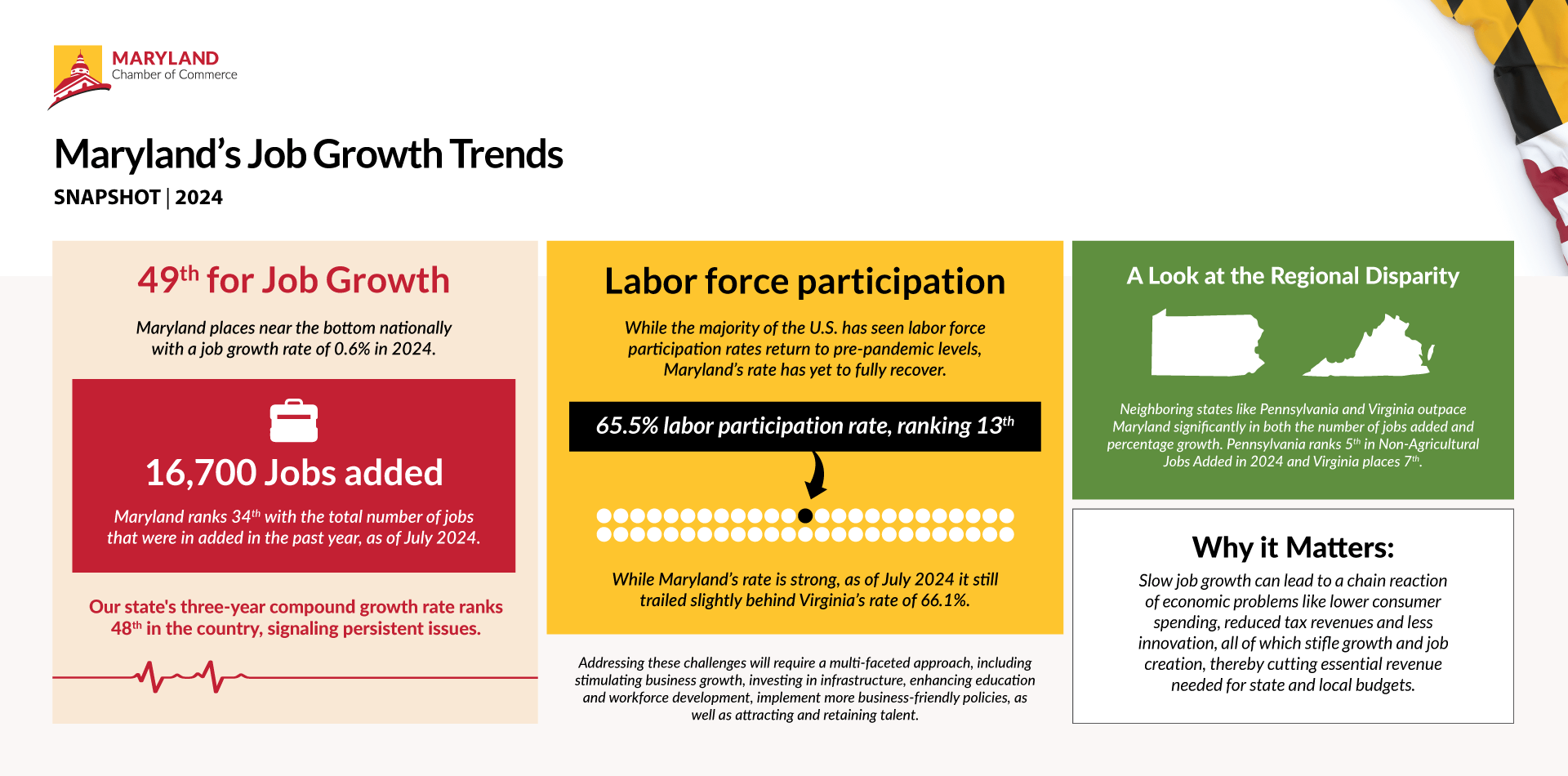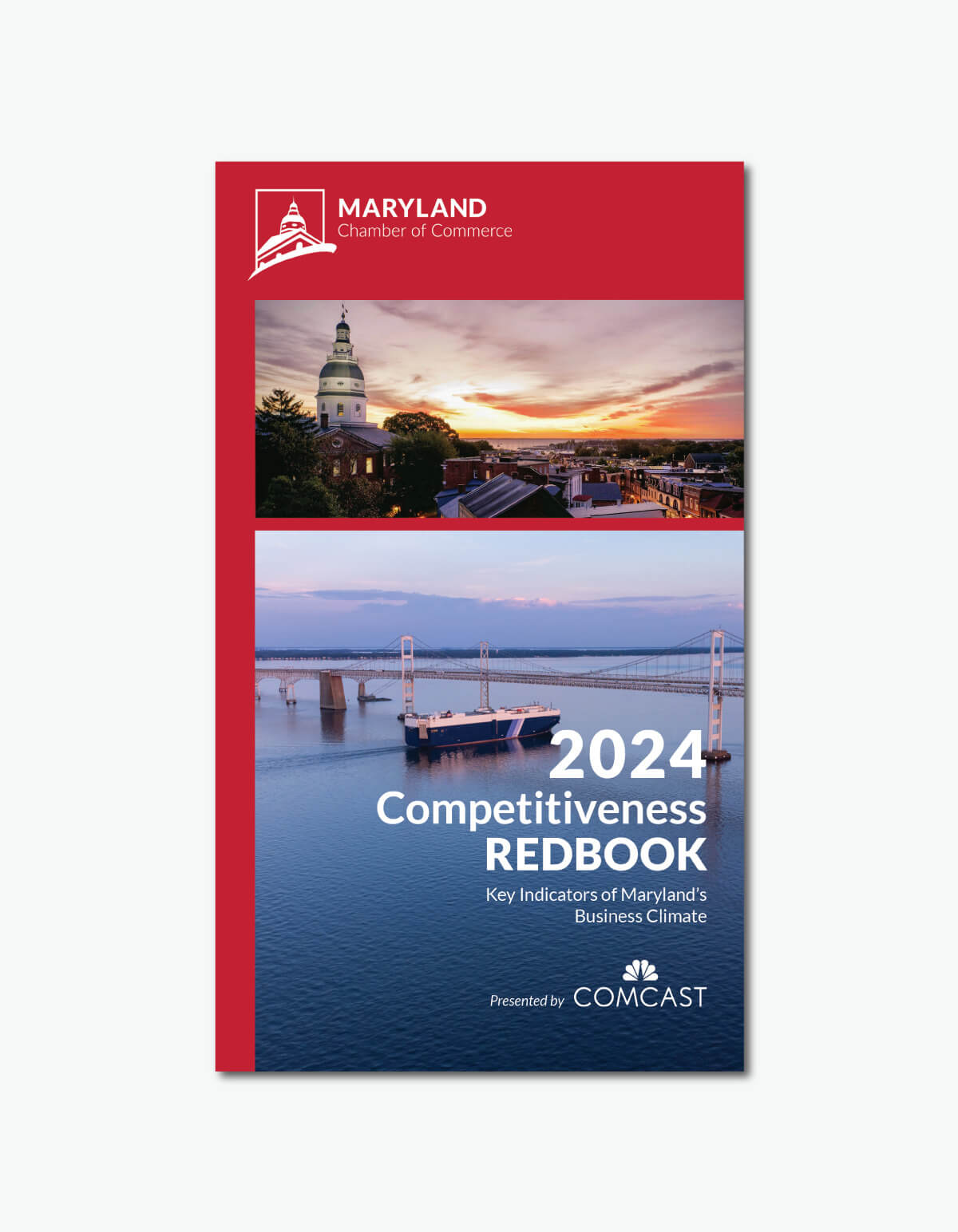Blog
Charting Maryland’s Economic Competitiveness in 2024: Job Growth
Nov 12, 2024
Examining Job Growth Trends in Maryland
Recent workforce data reveal troubling trends for Maryland’s economic competitiveness.
Challenges to Competitiveness
49th in Job Growth: Maryland ranks near the bottom nationally in job growth rate (0.6%) and 34th in total jobs added (16,700) over the past year.
Three-Year Growth Lag: The state's three-year compound growth rate ranks 48th in the country, signaling persistent issues.
Regional Disparity: Neighboring states like Virginia and Pennsylvania outpace Maryland significantly in both the number of jobs added and percentage growth.
Labor Force Participation: While Maryland's seasonally adjusted labor force participation rate 65.5% as of July 2024) is strong, ranking 13th nationally, it still trails slightly behind Virginia (66.1% as of July 2024). In addition, Maryland’s labor force participation rate has not recovered to pre-pandemic levels as has been the case throughout a majority of the U.S.
Charting Maryland’s Progress: Job Growth
| Md '21-'22 | Md '22-'23 | Md '23-'24 | Va '23-'24 | Pa '23-'24 | De '23-'24 | Best | |
| Non-Agricultural Employment Growth: Jobs Added | 22 | 37 | ↑ 34 | 7 | 5 | 49 | Calif. |
| Non-Agricultural Employment Growth: Percent Change | -- | -- | ↓ 49 | 14 | 18 | 35 | S. Carolina |
| 3-Year Compound Growth Rate as of July 2024 | -- | -- | 48 | 12 | 32 | 19 | Nebraska |
| Labor Force Participation Rates as of July 2024 | -- | -- | 13 | 9 | 28 | 39 | N. Dakota |
Data Trends
Maryland ranks 49th for job growth (0.6%) in the past year, adding just 17,200 non-agricultural jobs. Maryland also ranks poorly for its three-year compound growth rate, ranking 48th in the country.
Virginia and Pennsylvania are significantly outpacing Maryland when it comes to the number of jobs added and percentage change from 2023 to 2024.
Maryland’s Labor Force Participation Rate as of July 2024 was 65.5%, ranking 13th in the country. Virginia’s 66.1% labor force participation rate outpaces Maryland slightly.
Working Towards a Solution
Addressing these challenges requires a multi-faceted approach:
Stimulate Business Growth: Offer targeted incentives to attract and retain businesses.
Invest in Infrastructure: Support emerging industries with necessary infrastructure.
Enhance Education and Workforce Development: Equip the workforce with skills aligned with evolving market needs.
Implement Business-Friendly Policies: Create a regulatory environment that encourages business expansion.
Attract and Retain Talent: Develop an appealing living and working environment that draws talent to Maryland.
By addressing these factors, Maryland can reverse current trends, boost job creation, and enhance its overall economic competitiveness.
Sources
- State Populations: U.S. Census Bureau (2021, 2022, 2023 data)
- Non-Agricultural Employment Growth: U.S. Bureau of Labor Statistics (July 2024)
- Three-Year Compound Job Growth: U.S. News
- Labor Force Participation Rate: U.S. Bureau of Labor Statistics, Federal Reserve Bank of St. Louis, World Population Review (July 2024)
- Maryland State of the Economy Report: Office of the Comptroller (2023)
Key Takeaways
Maryland's slow job growth, coupled with stagnant population growth, points to deeper challenges in attracting and retaining both residents and businesses. High costs, burdensome regulations, high taxes and workforce issues are discouraging businesses from investing, expanding, or relocating here.
Together, these factors create a less competitive business environment, limiting opportunities for job seekers and making Maryland less appealing to new and growing businesses. This, in turn, weakens the state's attractiveness as a place to both live and work.
Why it Matters
Slow job growth can set off a chain reaction of economic problems — lower consumer spending, reduced tax revenues, unemployment rate increases and less innovation — all of which stifle growth. Maryland’s sluggish job creation limits opportunities for residents and cuts essential revenue needed for state and local budgets.




